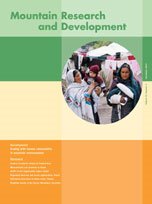Vulnerability to earthquake disasters in mountainous regions frequently escapes investigation and analysis. The tragic and costly earthquake disasters that have recently occurred in Central Asia have spurred important spurred important questions among local, regional, and international policymakers, scientists, and social activists regarding the root causes of earthquake vulnerability. Drawing on an analysis of recent earthquake disasters in Kyrgyzstan, Tajikistan, Afghanistan, and Pakistan, this article explores the concept of “seismic culture” (Degg and Homan 2005) in relation to vulnerability. Specifically, it argues that diminishing levels of indigenous hazard knowledge, demographic shifts, gendered livelihood transformations, and the lack of public access to science-based earthquake information have contributed to overall low levels of seismic cultures of prevention in the region. A major finding of the study points to the particular role of women in helping to redress the erosion of seismic culture, thereby bolstering local resilience, earthquake preparedness, and disaster risk reduction.
How to translate text using browser tools
1 November 2007
Vulnerability and the Erosion of Seismic Culture in Mountainous Central Asia
Sarah J. Halvorson,
Jennifer Parker Hamilton
Central Asia
Earthquake disasters
seismic culture
vulnerability
women





